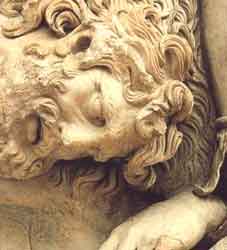.
The Hecatonchires or Hecatoncheires ("the hundred-handed") were figures of Greek mythology, giants with a hundred arms and fifty heads. They were children of Gaia and Uranus. Their father threw them into Tartarus, but they were rescued by Cronus and helped him overthrow Uranus by castrating him. After helping Cronus, he threw them back into Tartarus, where they remained, guarded by Campe, until Zeus rescued them. During the War of the Titans, they threw rocks one-hundred at a time at the Titans.
Afterwards the Hecatonchires became the guards of the gates of Tartarus. In the Iliad there is a story, found nowhere else in mythology, that at one point the gods were trying to overthrow Zeus but were stopped when Thetis brought a Hecatonchire to his aid. They are often considered sea-deities, and may be derived from pentekonters, longboats with fifty oarsmen.

Briareus (called Aegaion or Aegeon by Homer), from the Pergamon Zeus Altar
They were Briareus ("strong"), Gyges (or Gyes) and Cottu ("son of Cottytus"). Homer also referred to Briareus as Aegaeon ("goatish"), and said he was a marine deity and son of Poseidon.
In Latin, the Hecatonchires were also known as the Centimani.
See also : Greek Mythology. Paintings, Drawings
| Ancient Greece
Science, Technology , Medicine , Warfare, , Biographies , Life , Cities/Places/Maps , Arts , Literature , Philosophy ,Olympics, Mythology , History , Images Medieval Greece / Byzantine Empire Science, Technology, Arts, , Warfare , Literature, Biographies, Icons, History Modern Greece Cities, Islands, Regions, Fauna/Flora ,Biographies , History , Warfare, Science/Technology, Literature, Music , Arts , Film/Actors , Sport , Fashion --- |
Retrieved from "http://en.wikipedia.org"
All text is available under the terms of the GNU Free Documentation License

